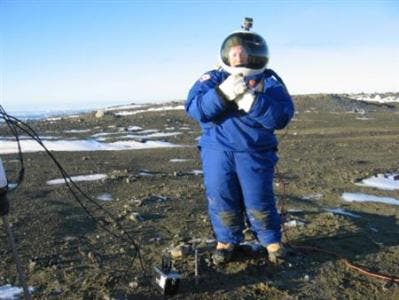
Argentine aerospace engineer Pablo de Leon (L), a NASA team member, tests a space suit designed for possible use in Mars at Argentina’s Marambio base in Antarctica in this handout photo dated March 13, 2011. (c) N.A.S.A.
A successful manned mission to Mars would launch mankind into a new space era, marking a historical moment; and however distant this prospect may be, scientists at NASA are already working on space suits tailored for the Martian environment. The NDX-1 space suit, designed by Argentine aerospace engineer Pablo de Leon with NASA funding, was tested recently in the Argentinian part of Antarctica where it was subjected to winds of more than 47 mph and freezing conditions.
“This was the first time we took the suit to such an extreme, isolated environment so that if something went wrong we couldn’t just go to the store” and buy a repair kit, said De Leon recently after returning from the one week expedition.
The NDX-1 $100,000 prototype suit is made out of more than 350 materials, including tough honeycomb Kevlar and carbon fibers to reduce its weight without losing resistance. Scientists wearing the suit, including its lead engineer Pablo de Leon, simulated spacewalks, sample collection, drilling and other simulations to see how the suit might behave if a manned mission were to set foot on Mars.
It’s not very comfortable though, as de Leon said it was bound to make anyone feel claustrophobic with its helmet and built-in headset for communicating with the outside world. De Leon, who heads the space suit laboratory at the University of North Dakota in the United States, said Antarctica was ideal for sample collection as it is one of the least contaminated places on earth and will also give clues about the suit’s impact.
“Mars is a mixture of many different environments: deserts, and temperatures and winds like in Antarctica,” De Leon said. “So we try to take bits of different places and try to see if our systems can withstand the rigors of Mars if we go there.”
It’s always exciting to see Mars projects developed or tested, but one can only wonder when a manned Mars mission will finally be kickstarted, especially considering the delicate situation NASA – the budgetary problems, that is. President Barack Obama said last year that by the mid-2030s it would be possible to send astronauts to orbit Mars and return them safely to earth.









